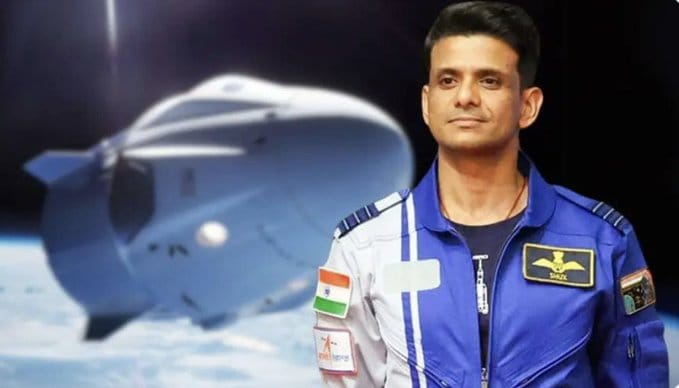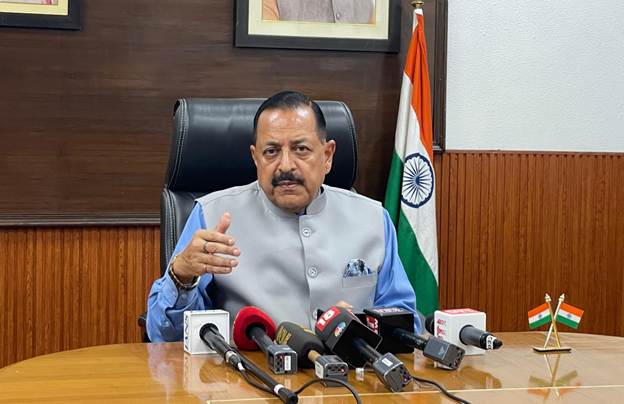Last Updated on June 26, 2025 9:59 pm by INDIAN AWAAZ
41 Years After Rakesh Sharma, Another Indian Astronaut Reaches Orbit
ANDALIB AKHTER
India marked a historic milestone in space exploration today as the SpaceX Dragon spacecraft, carrying the international Axiom-4 crew, including Indian Air Force Group Captain Shubhanshu Shukla, successfully docked with the International Space Station (ISS) at 4 p.m. IST. This momentous event places Shukla as only the second Indian to reach space, coming 41 years after Rakesh Sharma’s iconic 1984 mission.
Born in Lucknow, Shukla’s presence aboard the ISS represents not just individual excellence, but a proud leap forward for India’s space ambitions. His inclusion in the elite crew underscores India’s emergence as a serious global player in space science, innovation, and international collaboration.
A Global Mission, A National Pride
The Axiom-4 mission comprises four astronauts from the United States, India, Poland, and Hungary. Over 14 days, the crew will conduct scientific research in Low Earth Orbit, with their spacecraft docked to the ISS’s Harmony module. India’s participation in this high-profile international mission highlights its growing footprint in human spaceflight and advanced research.

India Leads Scientific Research in Space Nutrition
Group Captain Shukla will lead a series of cutting-edge experiments focused on food and space nutrition. These experiments—developed jointly by the Indian Space Research Organisation (ISRO) and the Department of Biotechnology (DBT), with support from NASA—are designed to deepen our understanding of sustainable life-support systems, a critical need for long-duration space travel.
One of the key research areas will be the behavior of nutrient-rich microalgae in space. Scientists aim to assess how microgravity and space radiation affect the growth, gene expression, protein synthesis, and metabolism of various algal species. This research could shape the future of food security in space missions and even inform solutions for sustainable nutrition on Earth.
India’s Space Legacy Reignited
The success of this mission reignites India’s human spaceflight legacy and signals a bold new chapter in international space collaboration. As the country prepares for its indigenous Gaganyaan mission in the coming years, Shukla’s presence aboard the ISS serves as a proud symbol of India’s scientific capability and global partnerships.
India is not just participating—it is leading. With its blend of world-class talent, innovation, and international cooperation, India is poised to be at the forefront of the next era in space exploration.
Union Minister of State (Independent Charge) for Science & Technology, Dr. Jitendra Singh, hailed the successful docking of the Dragon spacecraft with the International Space Station (ISS). Onboard is Group Captain Shubhanshu Shukla, the Indian astronaut who will be conducting seven fully indigenous microgravity experiments during his stay — a significant step in India’s space exploration journey.
Lauding the milestone, Dr. Singh said the mission reflects the spirit of Atmanirbhar Bharat (self-reliant India) and Vishwabandhu Bharat (India as a friend to the world), ideals envisioned by Prime Minister Narendra Modi. He noted that all the experiments to be carried out by Shukla have been entirely developed by Indian institutions and that the scientific findings will be shared globally to benefit all of humanity.
“India’s role in space exploration is no longer limited to the launchpad,” said Dr. Singh, who also holds responsibility in the Prime Minister’s Office, Department of Space, and Department of Atomic Energy. “We are now shaping the future of life and science in space. Group Captain Shubhanshu Shukla carries India’s scientific dreams to the frontiers of microgravity.”

The Axiom-4 mission marks India’s most direct contribution to space biosciences. The seven experiments being undertaken aboard the ISS, Dr. Singh announced, are poised to make vital contributions to sustainability in space and innovation on Earth.
The first experiment, developed by ICGEB and BRIC-NIPGR New Delhi, examines the behavior of edible microalgae in microgravity. The study will look at growth, metabolism, and oxygen-carbon dioxide recycling potential, which are critical for sustaining life on long-duration space missions.
The second experiment, a collaboration between UAS Dharwad and IIT Dharwad, explores the germination and nutritional profiles of sprouting seeds like moong and methi in space. The study is expected to help develop nutrient-rich, medicinal food options for astronauts.
The third experiment, from BRIC-InStem Bengaluru, investigates muscle regeneration in microgravity, aiming to understand and prevent the muscle loss astronauts typically experience during extended missions. Its findings may also inform rehabilitation therapies for patients on Earth.
In the fourth project, researchers from IISc Bengaluru are studying the survival and reproduction of tardigrades—microscopic organisms known for their resilience—in space conditions. This research is expected to provide insights into human survival strategies in extreme environments.
The fifth experiment, also by IISc, focuses on how astronauts interact with electronic displays in zero gravity. The data will guide the future design of spacecraft control systems to improve usability and safety.
Another experiment from ICGEB explores the growth of cyanobacteria using urea as a nitrogen source in space. Cyanobacteria’s ability to recycle carbon and nitrogen could make it a cornerstone of sustainable life support systems in extraterrestrial habitats.
The final experiment involves exposing seeds of rice, cowpea, sesame, brinjal, and tomato to space conditions to test their resilience. This research could pave the way for space agriculture and the development of climate-resilient crops for Earth.
“These pioneering efforts represent India’s emergence as a global leader in space biosciences,” Dr. Singh said. “We are no longer followers; India is now leading missions of planetary relevance. These experiments will open new frontiers for sustainable life in space and resilient ecosystems on Earth.”

